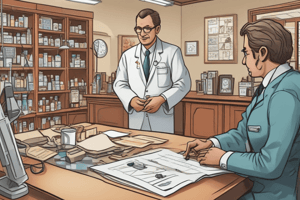Podcast
Questions and Answers
What does the 'ASMETHOD' mnemonic stand for in the context provided?
What does the 'ASMETHOD' mnemonic stand for in the context provided?
- Age, Symptoms, Medication, Extra medicines, Time persisting, History, Other symptoms, Danger symptoms (correct)
- Alertness, Symptoms assessment, Medication check, Extra doses, Temporal evaluation, Historical symptoms, Other risks, Displayed danger signs
- Appearance, Self-assessment, Medication review, Extra symptoms, Time duration, Health history, Other medicines, Distinct symptoms
- Assessment, Sickness description, Medicine examination, Extra drug doses, Time elapsed, Historical records, Other ailments, Distress signs
For what reasons does the pharmacist consider age when evaluating symptoms according to the text?
For what reasons does the pharmacist consider age when evaluating symptoms according to the text?
- To decide whether to refer a patient based on the type of symptoms
- To identify common conditions in different age groups for proper treatment
- To assess the risk of dehydration or seriousness of symptoms based on age (correct)
- To determine if the patient is likely to have a serious condition based on appearance
Based on the text, when might an adult with acute diarrhea be treated by the pharmacist?
Based on the text, when might an adult with acute diarrhea be treated by the pharmacist?
- When they are elderly and have diarrhea
- When they have no other symptoms besides diarrhea (correct)
- When they show signs of dehydration
- When they have been experiencing diarrhea for over a week
In the context provided, what is a sign that a baby experiencing acute diarrhea may require referral?
In the context provided, what is a sign that a baby experiencing acute diarrhea may require referral?
Why might a pharmacist be more cautious when deciding whether to treat oral thrush in a baby compared to an adult?
Why might a pharmacist be more cautious when deciding whether to treat oral thrush in a baby compared to an adult?
What impact does the appearance of a patient have on the pharmacist's decision-making process according to the text?
What impact does the appearance of a patient have on the pharmacist's decision-making process according to the text?
Why is it important for the pharmacist to know about all the medicines being taken by the patient?
Why is it important for the pharmacist to know about all the medicines being taken by the patient?
What should be considered if a patient has used multiple treatments without improvement?
What should be considered if a patient has used multiple treatments without improvement?
Why does the community pharmacist play an increasingly important role in detecting adverse drug reactions?
Why does the community pharmacist play an increasingly important role in detecting adverse drug reactions?
In what situations should a pharmacist consider referral to a family doctor?
In what situations should a pharmacist consider referral to a family doctor?
What do the abbreviations (NSAID) and (ACE) stand for in the context provided?
What do the abbreviations (NSAID) and (ACE) stand for in the context provided?
What are danger symptoms that should prompt a pharmacist to refer a patient to a doctor?
What are danger symptoms that should prompt a pharmacist to refer a patient to a doctor?
Which of the following scenarios would NOT require immediate referral to a doctor according to the text?
Which of the following scenarios would NOT require immediate referral to a doctor according to the text?
When should a person not go to A&E immediately based on the text?
When should a person not go to A&E immediately based on the text?
What is the abbreviation for 'Over The Counter' medicines as mentioned in the text?
What is the abbreviation for 'Over The Counter' medicines as mentioned in the text?
Which of the following symptoms does NOT indicate a higher risk of a serious condition according to the text?
Which of the following symptoms does NOT indicate a higher risk of a serious condition according to the text?
Based on the text, what sequence should a pharmacist follow when encountering danger symptoms in a patient?
Based on the text, what sequence should a pharmacist follow when encountering danger symptoms in a patient?





